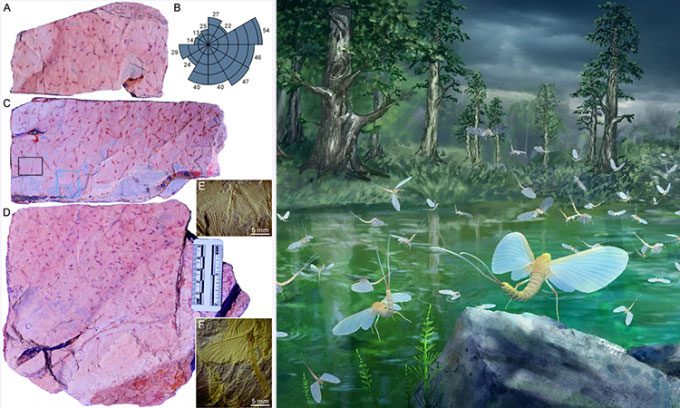Chinese scientists announced on June 7 the discovery of the earliest evidence of swarm mating behavior in insects found in 180-million-year-old fossils.
A research team from the Nanjing Institute of Geology and Palaeontology under the Chinese Academy of Sciences (NIGPAS) and the Guangxi Geological Survey discovered fossil fragments containing 381 prehistoric mayfly specimens belonging to a previously undescribed species named Jurassephemera zhangi in the Shiti Formation in the city of Hezhou, Guangxi Zhuang Autonomous Region, southern China.
In a report published in the journal Geology and Historical Biology on June 7, author Wang Bo from NIGPAS emphasized that this is a rare finding, providing the earliest evidence of swarm mating behavior in insects.
“Our new discovery shows that complex swarm mating behavior in insects was already established in the species Jurassephemera zhangi during the early Jurassic period,” Wang stated.

Fossils provide the earliest evidence of swarm mating behavior in insects. (Photo: NIGPAS)
All 381 mayfly specimens in the fossil fragments from Shiti are well-preserved with bodies, appendages, and wings intact. This indicates that they were not transported far by water after death.
Modern mayfly species spend most of their lives in aquatic environments as larvae, with the adults typically living only a few hours to a few days. During their brief adult stage, males gather in dense swarms. Females actively fly in to find mates and breed, subsequently selecting suitable locations to lay their eggs.
The order Ephemeroptera plays a crucial role in aquatic food chains. In the larval stage, they consume aquatic plankton and become food for fish and other predators.
Upon maturation, they fly above the water surface, contributing to terrestrial food chains. After mating and dying, their bodies become fertilizer for the plant communities around streams and lakes.

















































